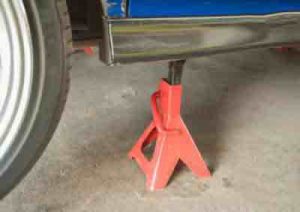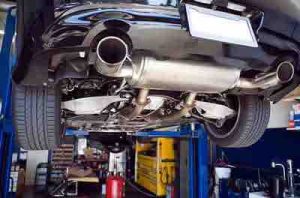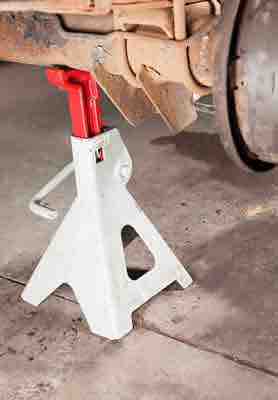Yes, you can jack your car up anywhere on the axle of your car. The axle is designed to transmit torque to the wheels, maintain the corresponding position of each wheel in relation to each other and the car.
The axle bears the weight of the car on both ends of the car, front and back. If you need to do repairs or change any of your tires, the front or the back axle are choice places to jack your car up on.
Make sure to apply safety precautions when jacking your car.
Table of Contents
How do you jack your car on the axle?
One important reason why you would need to jack up your car is that you need to replace or patch your tire.
It is impossible to do this while your car is sitting heavily on the tires. Accessory manufacturers have not left car owners with their devices, there is a whole range of tools to achieve your goal in the minimum time and with little stress.
You already know where the axle is on your car. It is a contraption of metal that connects the tires together in front and rear of the car.
Preliminary steps
- Check the axle weight of the car. It is written on a sticker on the pillar of the door of your car. It is important to know the weight of the axle so that you do not mismatch weights and cause injury to yourself or damage your jack.
- Check the weight specification of the jack and axle stand. Make sure they exceed that of the axle of the car. If your car axle weighs 930 kilos, which is under a ton, your axle stand and jack should weigh nothing less than a ton, that way the jack or axle stand won’t collapse under the weight of your car.
- Put the handbrake on.
- Put the gear on, or if the car is an automatic transmission car put it in park.
- Put a block against the tire as a precaution and safety measure to stop the car from rolling.
Steps to jack up your car by the axle
- Roll your jack under the car targeting the spot where the metal is reinforced.
- Begin to pump up and down with the lever until there is sufficient space for the axle stand to go under the car.
- Place the axle stand in position, make sure it fits properly under the car, then lock it in position before going about changing your tire.
Safety precautions when jacking up your car at the axle

It is important to follow safety precautions. The following precautions help you avoid injuries and accidents as you work on your car.
- Avoid putting any part of your body under the car while it is up on a jack. Do this to avoid unintended injuries.
- Make sure the car is on the same level as the ground, when you park it. Set the parking brake, and for manual transmission, put the gear in reverse. If the car is automatic, put the gear in park.
- Be sure that the jack is properly set in the proper jacking points under the car. An improperly positioned jack may cause damage to your car or injury to you.
- Absolutely avoid starting the car or running the engine while it is supported by a jack.
- If a bolt or nut should roll under your car while it is on a jack, absolutely avoid getting under it. The only time you should do this is if the vehicle is supported by stands.
- Make sure there’s no one in the car before you raise it. And if it’s an SUV with your family in it, and you are all in a wilderness, still ask everyone to step outside while you lift the car on the jack.
- When you need to work under the car, make sure to use jack stands placed in strategic positions that follow safety protocols.
- Don’t jack up your car without placing blocks behind the tires that are not raised. You can use wooden wedges, bricks, or any other object heavy enough and that is capable of preventing the vehicle from rolling.
- Avoid changing tires on the highway. Highways are risky places to have your car on jacks. Other vehicles are on high speed, and so should you. In case a moving vehicle loses control, you are a sitting duck with your car on jack stands.
- Jacks are designed to lift your car off the ground for when you need to change tires or do repairs under the car, not for holding the car in place. Avoid living your car on jacks for extended periods. The danger includes unaware persons who might lean on the car inappropriately and cause damage to the car or personal injury.
- Never park at corners on the road to raise your car on a jack. Oncoming vehicles may not see you and this will result in accidents.
Where should you not jack up a car?
Every vehicle comes with a manual that shows you the point where you can jack up your car. It is important to always follow the instructions therein.
- All vehicles have instruction manuals that outline the points where you can jack your car up.
- It is important to follow these instructions for safety purposes.
You should not jack your car at any point not specified by the manufacturer of the car.
Can I jack up my car on differential?
No, you shouldn’t. In other words, you can, it’s your car, isn’t it? You have probably seen someone do this.
People do a lot of stuff with their cars and get away with it. That does not mean you have to do same thing though.
The differential is referred to the system of gears that makes it possible for the wheels which the engine powers on the same axle to rotate at different speeds.
One of the reasons why you should avoid jacking up on the differential is because since the jack is also metal like the differential rods, there is a danger of slipping. If this happens it may lead to injury and damage to the differential.
Another risk of jacking on the differential is you might end up crushing a brake line.
You’ll succeed in creating more problems. You could attempt jacking up right under the pumpkin but only if you use axle stands on both sides of the car and withdraw the jack immediately.
Don’t put the jack under the following places:
- The engine.
The engine is encased in the middle of the subframe. It is risky to place your jack under the engine because you risk breaking or dislodging a component.
- Any point comprising of plastic.
Most cars have plastic undertray. You find them around the edge of the frame rails, around the back and front of the car.
They are not difficult to miss. Jacking under any such undertray is extremely risky.
For one thing, you have a false balance with the undertray, the grip either breaks or slips off, damaging your car and possibly causing injury to you too.
Is it possible for you to jack up a car on its subframe?
No. This is a risky thing to do to your car. The subframe may bend if you try to jack up under it.
One of the reasons this may happen is if the prong on your jack is small. A small prong has only a small surface area to cover as it bears the load of the car.
You may have heard some vehicle owners say they jack up their cars on the subframe. Don’t take their word for the whole thing. Folks usually don’t provide all the facts.
They may have gotten away with jacking on their car’s subframe because the prong on their jack is a flat, plastic-type, and they may have positioned it in the center of the subframe.
But even then, it is a risk you do not want to take with your car.
Can you put jack stands on control arms?
Jacking up at the control arm is risky. You may end up breaking or bending something down there.
However, the risk can be reduced if you place some soft padded material between the jack and the metal of the control arm. Doing this reduces the risk of a slip, forming a firm grip on the metal.
Another way to avoid damage or breaking the control arm is to lift from below the ball joint close to the wheel or under the spring. But do this only if you are not doing anything around that spot.
The important thing when jacking up around the part of your car is to avoid any weak points or spots where there’s likely to be a break or crack.
Can you jack up on frame rails?
Most cars have tough frame rails, so yes, you can jack up the car’s frame rail. Just be certain you are jacking up on the frame rail and not the unibody.
The frame rail is typically constructed using steel channel sections, so they are sturdy, strong enough to bear the weight of the car on a jack.
An important piece of advice is to always remove the jack once you have your stands in place, and that you do this on a flat surface to minimize risks.
Can you jack a truck up on the frame?
Yes, you can jack up the frame. Just make sure you’re using a jack that is a corresponding tonnage for your truck.
Also, follow the manufacturer’s instructions for your truck. Make sure too that the jack has enough travel to carry the truck all the way up for there to be space for your work.
Once the truck is up on the jack, place two jack stands on either side of the frame of the truck for maximum stability.
Absolutely do not rely on the jack alone to work, take it out immediately you are sure the jack stands are in their proper places.
Can you jack a car up in the middle?
Jacking your car up in the middle is one very risky thing to do. Firstly, there is a risk of the car flipping over on account of the imbalanced distribution of weight. Secondly, the jack may cause a dent in the frame rail if it runs across the underside of the car there.
So no, it is not advised to jack your car in the middle. It is recommended that you stick with using the jacking points on the car.
You must bear in mind that your car is not designed to be jacked from every conceivable point.
Your manual shows those points where it is safe to jack your car, and none of it usually includes the middle.
Can I use a 2-ton jack on a 3-ton car?

Most small cars the size of sedans can be jacked on one side by a 2-ton jack since it is required that the jack be rated for at least three-quarters of the car’s entire weight.
If your vehicle is a pickup or a truck, you’d require a 6-ton jack. You don’t necessarily require a jack that is rated for the total weight of your car.
So, for your small to midsize car, a two-ton jack is ideal. Follow the safety precautions that require that you remove the jack after the car is lifted and stands have been installed.
Should you also use a 2-ton jack for your truck? SUV? Well, yes, you can. So long as your truck is within is below 4 tons (8000lbs), you can use the 2-ton jack on it.
Remember that you are only lifting one side of the truck, not the entire vehicle. Always practice safe jacking by never getting under the car or truck while it’s on a jack. If possible, use jack stands, then pull off your jack.

